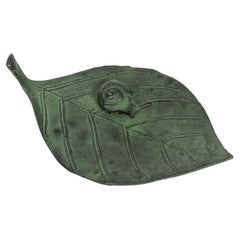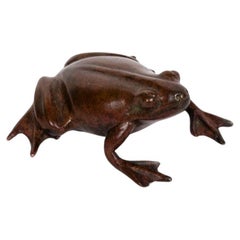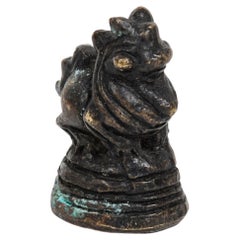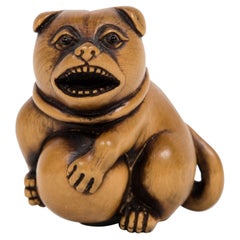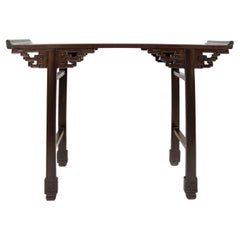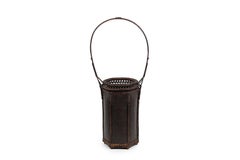Sylvie Tiago
to
59
44
32
24
22
17
9
7
6
6
5
2
2
2
1
1
1
1
1
Japanese Bronze leaf and snail tray signed Ishikawa Toshio (1919-2006, 石川敏夫)
Located in PARIS, FR
Small bronze tray with green patina in the shape of a leaf with a snail on it.
Signature underneath « Toshi » (敏) Ishikawa Toshio.
Sold with its transport box
Japan, Ishikawa Toshio...
Category
Vintage 1960s Japanese Showa Metalwork
Materials
Bronze
Japanese Tiny bronze frog
Located in PARIS, FR
Adorable tiny bronze frog in cast bronze with a splendid brownish patina, almost
orange, lying on its rear legs, ready to jump. The casting of this bronze was very well
conducted, ...
Category
Antique Late 19th Century Japanese Meiji Metalwork
Materials
Bronze
Opium Wieght in the Form of a Buddhist lion
Located in PARIS, FR
Tiny opium weight in bonze with brownish patina in the shape of a Buddhist guardian lion, also name Fo dog, characteristic with its exorbitated eyes and an embossed and wavy mane and...
Category
Antique Late 19th Century Cambodian Folk Art Metalwork
Materials
Bronze
Japanese Puppy Nestuke in boxwood
Located in PARIS, FR
Netsuke in boxwood representing a puppy with incrusted eyes made of buffalo horns. Its mouth is open, as if it was barking, it also wears a knotted collar and holds a ball between it...
Category
Antique Mid-19th Century Japanese Edo Sculptures and Carvings
Materials
Boxwood
Chinese Altar or Console made of exotic wood
Located in PARIS, FR
Chinese altar also used as console or side table. Made of exotic hard wood, probably zitan, with a dark patina. It features voluptuous flared edges and spandrels carved in cloud moti...
Category
Early 20th Century Japanese Qing Furniture
Materials
Hardwood, Zitan
Hexagonal Japanese Ikebana Basket with an Oblong handle
Located in PARIS, FR
Hexagonal Chinese-style rattan and bamboo hanakago basket for ikebana (karamono hanakago). It features a lacquered and brushed bamboo vase.
The body is tightly braided horizontally, ...
Category
Antique Mid-19th Century Japanese Showa Decorative Baskets
Materials
Wicker
Japanese Okimono of a Wooden Toad with its eyes inlaid
Located in PARIS, FR
Carving of a wooden toad with eyes inlaid in hard stone. Its surface is carved with great precision in order to grant him a both smooth and grainy texture, it stands in an amusing pa...
Category
Early 20th Century Japanese Taisho Sculptures and Carvings
Materials
Hardwood
Japanese Netsuke of a croaking Toad in boxwood
Located in PARIS, FR
Netsuke of a wooden toad with its throat swollen. Made entirely in boxwood, the skin is treated with detail, the naturalistic pause suggests that the toad is croaking, the smooth tex...
Category
Antique Late 18th Century Japanese Sculptures and Carvings
Materials
Boxwood
Japanese Professional sneezer Boxwood Netsuke
Located in PARIS, FR
Boxwood netsuke of a seated professional sneezer depicted as an old man with his right hand raised, holding an stick to tickle himself. His head is slightly raised, his eyes practica...
Category
Antique Late 18th Century Japanese Edo Sculptures and Carvings
Materials
Boxwood
Japanese Bronze sculpture of a Mouse holding a korn knob
Located in PARIS, FR
An interesting bronze sculpture of a seated mouse holding a small corn knob. Realistic treatment of the fur, eyes, hears nose and mouth, its tail is curving on the left side of the s...
Category
Antique Late 19th Century Japanese Meiji Metalwork
Materials
Bronze
Japanese Bronze sculpture of a standing Mouse holding an Hazelnut
Located in PARIS, FR
It is a very convincing bronze sculpture of a mouse with a light brown patina, represented with an astonishing set of detail on its eyes, nose and fur. She is seated on her rear paws...
Category
Antique Late 19th Century Japanese Meiji Metalwork
Materials
Bronze
Important Japanese Ikebana basket of an Oblong form
Located in PARIS, FR
Hanakago basket for ikebana in rattan and bamboo. Oblong, rounded on the sides, it features a lacquered bamboo vase.
Rattan braiding scattered over the body, tightly woven over the ...
Category
Antique Mid-19th Century Meiji Decorative Baskets
Materials
Bamboo, Wicker
Japanese glazed Sandstone Teapot in the form of a Turtle
Located in PARIS, FR
Sandstone teapot in the shape of a turtle, the inside is enameled. The outside circumferences of the lid and the part in contact with the table are not enameled.
Japan – Taishô er...
Category
Early 20th Century Japanese Taisho Ceramics
Materials
Sandstone
Japanese bronze of a Snail in a Naturalist Pose
Located in PARIS, FR
Bronze with a brown patina representing a snail with a very interesting pose. Its angular pose suggests that it could be exposed in such a way that he would mimic a real snail going ...
Category
Antique Late 19th Century Japanese Meiji Sculptures and Carvings
Materials
Bronze
Japanese Namban Chest adorned with cylindrical motives and mother of pearl inlay
Located in PARIS, FR
Small namban style chest with a semi-cylindrical lid made of black lacquered wood (urushi) with gold lacquer (maki-e) and inlaid with mother-of-pearl (raden).
Mon style decoration (...
Category
Antique Mid-18th Century Japanese Lacquer
Materials
Lacquer, Mother-of-Pearl
Japanese lacquered Inro chrysantemum
Located in PARIS, FR
Beautifull Inro of three compartments made in kinji lacquer with an hiro maki-e
ornament chrysanthemum flowers of gold and silver lacquer. Inside is in fundame
lacquer.
Signed by J...
Category
Antique Mid-18th Century Japanese Lacquer
Materials
Lacquer
Boxwood netsuke representing a ducthman with child and a trumpet
Located in PARIS, FR
Wooden netsuke of a standing Dutchman figure with his mouth open, leaning forward. He is wearing a long curly wig, a ruff and a long coat tied at the waist. In his right hand, the ma...
Category
Antique Late 18th Century Japanese Japonisme Sculptures and Carvings
Materials
Boxwood
Japanese Monkey Suaka
Located in PARIS, FR
Bronze sculpture of a monkey laying on a golden brass tray adorned with copper
leaves. This sculpture is made of sentoku and shibuchi bronze with a very interesting
suaka patina.
...
Category
Antique Late 19th Century Japanese Sculptures and Carvings
Materials
Bronze
$2,133
Japanese lacquered Cherry Tree Kobako
Located in PARIS, FR
Kobako in nashiji lacquer of square shape with a hira maki-e décor of a blossoming
cherry tree. Both of the four sides are adorned with golden lacquer cherry flowers,
represented i...
Category
Antique 19th Century Japanese Lacquer
Materials
Lacquer
Inro Dragon
Located in PARIS, FR
Beautifull inro of six compartments made of black gold, silver and tin lacquer,
representing a dragon on each side, surrounded by black and silver clouds, the inside
is made of nas...
Category
Antique Early 19th Century Japanese Japonisme Lacquer
Materials
Lacquer
$11,851
Japanese ikebana bamboo basket - Showa, 20th
Located in PARIS, FR
Ikebana basket (hanakago) in wickerwork of polished bamboo with twisted handle. Features a sheet metal and varnished bamboo vase for the floral arrangement.
Mark under the vase Nana...
Category
20th Century Japanese Japonisme Decorative Baskets
Materials
Bamboo, Wicker, Wood
Japanese ikebana bamboo basket - Showa, 20th
Located in PARIS, FR
Ikebana basket (hanakago) made of dark brown varnished bamboo wickerwork rounded shape with a twisted handle.
Ikebana or Ka-do (the way of flowers) is a traditional Japanese art of...
Category
20th Century Japanese Japonisme Decorative Baskets
Materials
Bamboo, Wicker, Wood
Japan lake landscape kobako box lacquer - Edo
Located in PARIS, FR
Rectangular kobako box in takamaki-e and kirigane gold lacquer circled with pewter depicting a lake landscape. Inside and back of the box in nashi-ji lacquer.
Japan – Edo period (16...
Category
Antique 18th Century Japanese Lacquer
Materials
Gold
Japan bronze cicada sculpture okimono Meiji
Located in PARIS, FR
Bronze sculpture with dark brown patina of a cicada.
The cicada (in Japanese, semi) is considered as a symbol of humanity. Together with a praying mantis and a spider, they represen...
Category
Antique Late 19th Century Japanese Japonisme Sculptures and Carvings
Materials
Bronze
Japanese round shaped rabbits bronze pair Hiroharu Hiramatsu Showa era
By Hiroharu Hiramatsu
Located in PARIS, FR
Pair of bronze rabbits running, their legs forming a round shape.
Made by Hiroharu Hiramatsu (1896 Hyôgo prefecture – 1971, Fukushima,平松宏春). Specialized in metal art, he is a counci...
Category
Vintage 1930s Japanese Japonisme Sculptures and Carvings
Materials
Bronze
Japanese small round bronze hare Meiji era
Located in PARIS, FR
Small round hare in bronze with dark brown patina, standing on its four legs.
In Japanese, the hare and the rabbit are referred to by a single word: usagi. The animal is one of the t...
Category
Antique Late 19th Century Japanese Japonisme Sculptures and Carvings
Materials
Bronze
Japanese golden kobako flowers Edo period 18th century
Located in PARIS, FR
Quadrangular kobako box decorated with flowers in gold and blue lacquer with aogai inlay. Lid and sides in fundame lacquer, underside and interio...
Category
Antique 18th Century Japanese Japonisme Lacquer
Materials
Gold
Japanese bronze okimono toad (sculpture)
Located in PARIS, FR
Okimono bronze sculpture of a large toad in a crouching position, possibly about to jump.
The toad and the frog, referred to by the same term in Japanese (kaeru), are associated with...
Category
Antique Mid-19th Century Japanese Japonisme Metalwork
Materials
Bronze
Japanese landscape pine kobako box Edo period 18th century
Located in PARIS, FR
Rectangular black and gold lacquer kobako box decorated with pine trees in a mountain landscape in takamaki-e, kirigane and hiramaki-e lacquer. Background in nashi-ji lacquer. Surmou...
Category
Antique 18th Century Japanese Lacquer
Materials
Gold
Japanese peony basket lacquered box Edo
Located in PARIS, FR
Eight-sided, flared shaped lacquer kobako box, following the decoration on the lid depicting a basket of flowers, composed of peonies and chrysanthemums in gold takamaki-e and hirama...
Category
Antique 18th Century Japanese Edo Lacquer
Materials
Gold
Japanese suzuribako lacquered box peony river
Located in PARIS, FR
Suzuribako box (empty) in black lacquer. Gold maki-e decoration of a river bordered by peonies, one with red highlights. The edges of the lid are in gold lacquer. Nashi-ji interior.
Category
Antique Late 19th Century Japanese Lacquer
Materials
Gold
Japan chrysanthemum tsuba
Located in PARIS, FR
Iron tsuba in the shape of a chrysanthemum (kikugata), openworked in negative with foliage and geometric patterns. Chrysanthemum shaped tsuba were quite popular in the Edo period as...
Category
Antique Mid-18th Century Japanese Metalwork
Materials
Gold, Iron
Japan medallions tsuba Tanaka school Edo period
Located in PARIS, FR
Ovoid-shaped (nagamarugata) iron tsuba hammered and chased with medallions. On one side, medallions of a dragon with gold highlights and a komainu (or shishi – lion dog guarding the ...
Category
Antique Mid-18th Century Japanese Metalwork
Materials
Gold, Iron
Japan mice treasure bag Meiji
Located in PARIS, FR
Japanese bronzewith brown patina representing two mice. One is pulling pulling a treasure bag. crouching down with its head turned to the left. While the other mouse is standing on i...
Category
Late 20th Century Japanese Japonisme Metalwork
Materials
Bronze
Japanese Bronze Hawk Ikebana
Located in PARIS, FR
Bronze intended for hanging (? dô kakenanaike, « hanging bronze ») depicting a hawk, placed on a branch. The inside is hollow so a bouquet a flowers can be put inside and thus, serve...
Category
Antique Late 19th Century Japanese Metalwork
Materials
Bronze
Japanese Bronze Kappa
Located in PARIS, FR
Dark brown patina bronze figure of a standing kappa with its right leg leaning on a cucumber. The figure is put on four-legged rattan-like bronze stand.
The kappa (??) is a aquatic creature taken from Japanese folklore having the appearance of an anthropomorphic turtle.
His skull is either slightly hollowed out to accommodate water, from which it derives its power, or hidden with a water lily leaf hiding this sag. Naturally polite, it is advisable to bow to him in order that it should do so in return, thus losing all the water he has gathered and leaving it harmless.
Kappa has the reputation of attempting to lure both humans and animals into the water. In some areas, it ravages fields, stealing eggplants and cucumbers. Some people prefer to worship it and give it offerings rather than be its victims.
Signed Shokaken (???). His real name is Ôshima Yasutarô. He was born in 1849 and is the third generation of a metalworkers family. Together with his brother Ôshima Joun...
Category
Antique Late 19th Century Japanese Metalwork
Materials
Bronze
$5,333
Japanese Bronze Group of Mice, Pumpkin and Pomegranate
Located in PARIS, FR
Polychrome bronze of a group of mice around a pumpkin and a pomegranate. The five mice have a dark brown patina, while the hollowed-out gourd is dark brown and the split pomegranate ...
Category
Antique Late 19th Century Japanese Metalwork
Materials
Bronze
Pair of Japanese Abumi Stirrups
Located in PARIS, FR
Pair of stamped brass stirrups decorated with Hashizuka, Ito and Manabe Mons.
Japan - Edo (1615-1868), 18th century.
Height: 10.24 in. (26 cm), length: 12.6 in. (32 cm), width 4.72 in. (12 cm)
As in Western culture, the culture Japanese stirrups were part of traditional accessories...
Category
Antique Late 18th Century Japanese Metalwork
Materials
Brass
$7,110 / set
Momoyama Namban Chest
Located in PARIS, FR
Namban chest with a semi-cylindrical lid made of black lacquered wood (urushi) with gold lacquer (maki-e) and inlaid with mother-of-pearl (raden).
Decorated with three main bands o...
Category
Antique 17th Century Japanese Antiquities
Materials
Lacquer
$41,480
Wakasa-Nuri Lacquer Bundai, Ryoshobako, Fubako Set
Located in PARIS, FR
Set of bundai, ryoshibako and fudebako in wakasa lacquer with an old rose background and black traditional Japanese patterns.
The saya pattern (or sayagata) is composed by Chinese svastikas. This symbol linked to Buddhism, mean intelligence, power and peace. It is a good omen sign.
The kanoko pattern reminds stains on fawn back.
The sakura (cherry blossom) pattern is emblematic of Japan. The blossoming in a short time marks spring beginning and is a symbol of renewal and ephemeral beauty.
There are also traces of calligraphy brush, in reference to the function of the objects.
Bundai is a low table used to put books or scrolls and, later, to write.
Rectangular ryoshibako (letter and document box) with a slightly domed
Fudebako (pencil case) of rectangular format very narrow in its length with two rounded corners, flat cover.
Wakasa lacquerware...
Category
Early 20th Century Japanese Lacquer
Materials
Lacquer
Fine Japanese Black and Gold Lacquer Sageju-Bako - Picnic Box
Located in PARIS, FR
Black and gold lacquer sageju-bako (picnic box) decorated with floral motifs in hiramaki-e. It includes a sake bottle, a four-compartment box with nashi-ji lacquer inside, a simple tray and a hollow tray. At the top, there is a bronze handle for transport.
The sageju-bako is divided into four superimposed boxes for food on the left; a simple tray, a sake bottle and a hollow tray on the right. They are in the shape of a plum blossom.
On the top, on both sides a phoenix. The phoenix (hôo) has an imperial and solar symbolism. This auspicious bird also embodies virtues taken from the teachings of Confucius (such as goodness, righteousness and wisdom).
The left boxes are patterned with turtles, plum tree, bamboo, cherry blossoms, water plantains near rivers. The two trays on the right have a shell and seaweed pattern. The sake bottle is decorated with a plum tree and bamboo.
On the sides, calabash decoration. Borders in saya (or sayagata) pattern, composed of Chinese swastikas...
Category
Antique Early 19th Century Japanese Lacquer
Materials
Lacquer
Japanese Black and Gold Lacquer Kushibako
Located in PARIS, FR
Kushibako (comb box) in black lacquer with gold lacquer decoration of arrows and my in the shape of three assembled commas " mitsudomoe " (Okabe; Itakura; Kuki; Hijikata; Arima famil...
Category
Antique Late 19th Century Japanese Lacquer
Materials
Lacquer
Japanese Lacquered Tebako 'Box'
Located in PARIS, FR
Tebako box with three compartments in golden and nashi-ji lacquer, decorated with golden, red, and kirigane lacquer, golden persimmon tree leaves, among rocks. The compartments are of increasing size from the top. The decoration is in continuity.
Persimmon has been cultivated in southern China for more than 2500 years and is believed to have been introduced to Japan in the 8th century. The veneer is a tree with very hard wood, similar to ebony. According to a legend, one specimen survived the atomic bombing of Nagasaki on August 9, 1945, close to the epicenter. It is therefore in Japan a symbol of strength and longevity. It is also the national fruit of the country. It is eaten as a traditional dish during New Year's Day celebrations.
Tebako literally means "portable box...
Category
Antique 1860s Japanese Lacquer
Materials
Lacquer
Japanese Lacquered Furoshiki Kobako 'Box'
Located in PARIS, FR
Rectangular and flat lacquer Kobako (small box) representing a furoshiki knot seen from above. Fundame background, furoshiki in takamaki-e with floral pattern, inside the folds of the fabric with black and gold sayagata pattern with togidashi maki-e technique. The saya (or sayagata) pattern is composed of Chinese swastikas...
Category
Antique Late 19th Century Japanese Lacquer
Materials
Lacquer
Japanese Lacquered Natsume 'Tea Box'
Located in PARIS, FR
Natsume in dark red lacquer, decorated with autumn leaves and cherry blossoms in hiramaki-e and nashiji. Interior in black lacquer.
Maple leaves (Momiji) are celebrated in literatur...
Category
Mid-20th Century Japanese Lacquer
Materials
Lacquer
Japanese Bronze Vase
Located in PARIS, FR
Patinated bronze vase decorated with a flying phenix and paulownia leaves.
It comes with its tomobako marked with the date Shôwa 5 (1930).
Japan, Shôwa period (1926-1989), 1930
...
Category
Vintage 1930s Japanese Vases
Materials
Bronze
$4,148
Mounted Imari Porcelain Perfume Fountain
Located in PARIS, FR
Perfume fountain in porcelain Imari kinrandé mounted in gilt bronze from the same set of porcelain. The cup and the bowl form the base, the pot covers the perfume container...
Category
Antique Late 18th Century Chinese Ceramics
Materials
Bronze
Pair of Japanese Bronze Grasshopper Vases
Located in PARIS, FR
Insects (mushi) occupy an important place in Japanese culture. Hunting for insects is a popular pastime, especially among children. Using plastic nets and cages, they catch cicadas and beetles to observe them.
Between 1830 and 1832, Hokusai composed an untitled series of ten large horizontal prints...
Category
Antique Late 19th Century Japanese Metalwork
Materials
Bronze
$5,925 / set
Agate Bowl
Located in PARIS, FR
Oval cut and polished agate bowl with an engraved brass mount. The setting is decorated with cranes and plum blossoms, of Japanese inspiration.
Europe, Germany or Italy – Early 20...
Category
Early 20th Century European Vases
Materials
Agate, Bronze
$4,740
Japanese Black and Gold Lacquer Kaioke Boxes 'Hokaibako'
Located in PARIS, FR
Two big eight-sided kaioke boxes in black lacquer, decorated with mon and maple leaves in golden lacquer.
These are usually octagonal boxes containing the painted shells used in ...
Category
Antique Late 19th Century Japanese Lacquer
Materials
Lacquer
Japanese Screen "the Song of Everlasting Sorrow"
Located in PARIS, FR
Six-panels screen depicting the exit from the city of a Chinese emperor on horseback and his concubine in a luxurious palanquin.
It may be a scene illustrating the poem The Song of Everlasting Sorrow (Chang hen ge, ???) written by Bai Juyi (772-846), which recounts the tragic love story between the emperor Ming Huang (also known as Tang Xuanzong, 685-762) and his favorite concubine, the beautiful Yang Guifei...
Category
Antique Late 17th Century Japanese Paintings and Screens
Materials
Silk, Wood, Paper
Japanese Smoking Set 'Tabac-Ire'
Located in PARIS, FR
Smoking set (tabako-ire) composed of a pipe (kiseru), a pipe case (kiseruzutsu) and a tabacco pouch (tonkotsu) for women linked to a netsuke.
Intended f...
Category
Antique Late 19th Century Japanese Antiquities
Materials
Metal
Gold Lacquer Inro Decorated with a Lake Landscape
Located in PARIS, FR
Inro with four gold lacquer boxes, decorated with a lake landscape. Accompanied by a bronze ryusa manju.
Small boxes formed of compartments that fit one on top of the other, inro (? ?) are traditional Japanese clothing...
Category
Antique Mid-19th Century Lacquer
Materials
Lacquer
Black and Gold Lacquer Suzuribako 'Writing Set'
Located in PARIS, FR
Black and gold lacquer suzuribako (writing set) in takamaki-e on a nashi-ji background representing two tigers near rocks, bamboos and plum blossoms in a night landscape. Inside of the lid with a lake landscape.
The interior of the suzuribako is composed with an inkstone, topped by a copper water bucket in the shape of a chrysanthemum on the left side, with a brush and a small knife. It includes in the right part a storage compartment.
Inscription under the inkstone "Inkstone made by Nakamura Chobe".
Although the tiger is not native to Japan, it has a high symbolic. The figure of courage was introduced by Buddhism from China. According to the Chinese tradition, the tiger is from one of the stars of the Great...
Category
Antique Late 18th Century Japanese Lacquer
Materials
Lacquer
Owl on a Tree Stump
Located in PARIS, FR
Bronze sculpture representing an owl on a tree stump covered with ivy. The owl, detachable from its base, has shakudo eyes. It is certainly an Ryûkyû scops ...
Category
Antique Late 19th Century Japanese Metalwork
Materials
Bronze
$16,592
